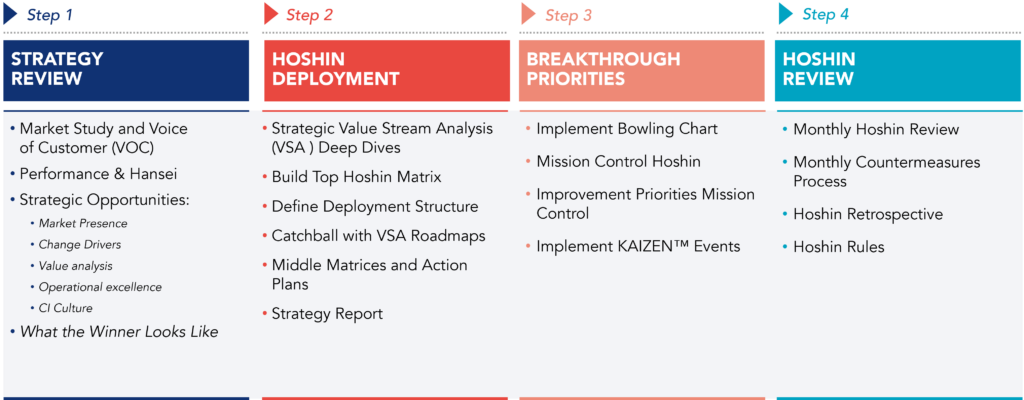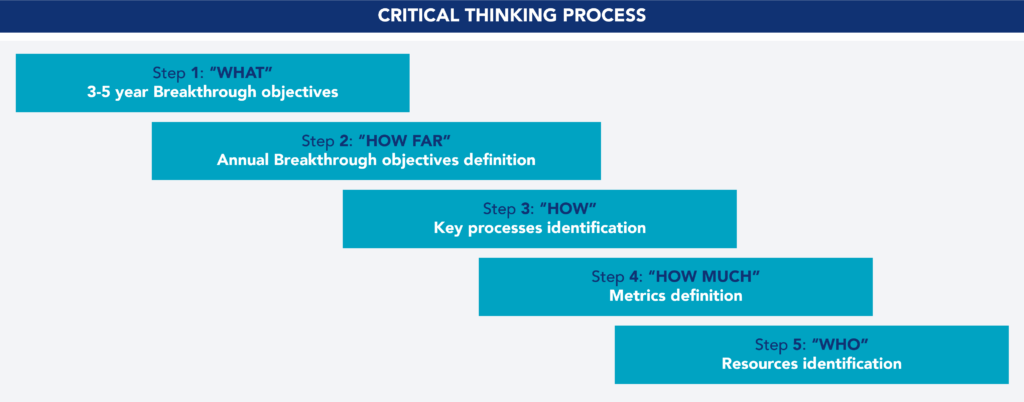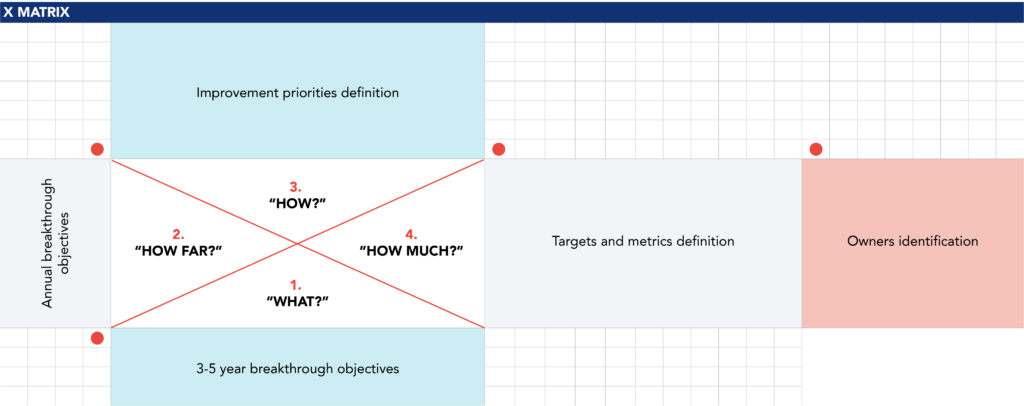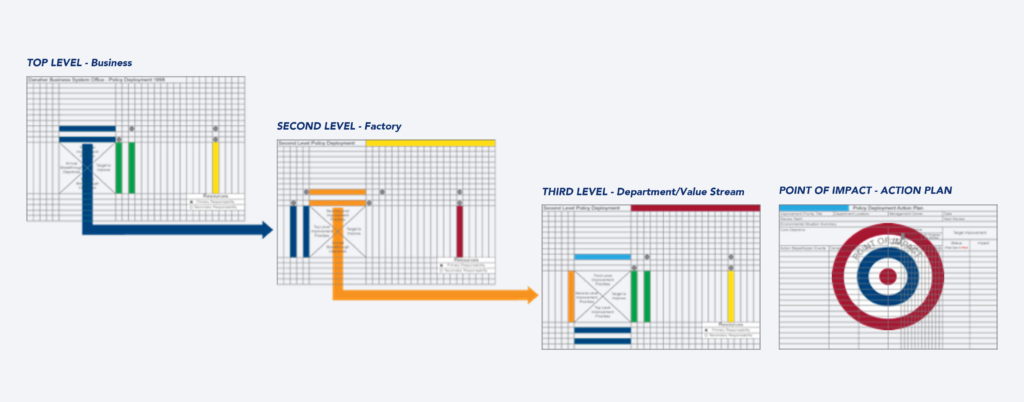Ensuring the right strategy implementation is a challenge all organizations face. There is a methodology that stands out as a powerful tool for creating alignment, ensuring that the entire company is focused on what is truly important: high-impact initiatives. This methodology is known as Hoshin Kanri and has been widely adopted by companies seeking to stay ahead of their competitors.
We will explore the concept of Hoshin Kanri and how it is applied to align goals and resources throughout the organization. We will see how this process begins with the definition of the strategy and ends with a clear description of the necessary changes at the point of impact. In this place, real improvement is achieved by identifying root causes and implementing solutions.
The Role of Strategy Deployment in Organizations
Achieving high and sustained growth is an objective for any company. Unfortunately, many organizations fail to achieve it. Studies reveal that only a small fraction, about 10% of companies, manage to drive consistent and profitable growth over time.
The key to tackling this challenge lies in two fundamental, connected elements: strategic planning and strategic deployment. Strategic planning establishes the roadmap of what the company wants to achieve in the long term, defining the direction. On the other hand, strategic deployment is the tactical plan, representing how these goals will be executed in the short term. Both are vital for organizations to achieve significant results.
Many companies face difficulties in these processes due to a series of common errors:
- Lack of commitment and involvement from management: When leadership is not fully committed to the strategic process, the plan is more likely to fail.
- Absence of objectivity and significant perspective: Defining clear and realistic goals and having an objective view of the market and internal capabilities is essential.
- Excessive complexity: Making the process too complex can make the plan difficult to understand and implement.
- Lack of a schedule or failure to follow it: Not creating or not following a timeline can result in delays and loss of focus.
- Strategic plan reduced to budgeting: Strategy should not be just about financial investment.
- Underestimating the required resources and their availability: It is essential to accurately understand the resources needed and available to achieve strategic goals.
- Failure to monitor progress: The absence of regular and standardized monitoring can result in significant deviations from strategic objectives, causing corrective actions to be taken too late.
- Failure to define success in quantifiable terms: Clear goals and indicators are needed to assess success and make adjustments as necessary.
These are just a few of the many mistakes that occur in strategy implementation. The path to sustainable and healthy growth requires a solid strategic approach and structured execution. Avoiding these errors is crucial for companies seeking consistent and positive long-term results.
The Steps Involved in Implementing a Strategy
Strategy implementation is a fundamental process to ensure that organizations’ strategic objectives are achieved. It involves translating high-level goals into tangible actions, aligning all parts of the organization with the strategic vision.
Next, we will describe the four fundamental stages of planning, deployment, and strategy implementation.

Strategy Review
In this phase, it is crucial to ensure agreement among decision-makers on the organization’s strategic direction. The process begins with defining significant objectives, called “Breakthroughs,” which are translated into improvement priorities. This directly links strategy to actual action.
The main steps of this phase are:
- Data Collection and Preparation: Gather data about the organization, financial data, strategic documents, and market studies, among others.
- Reflection on Performance and Hansei: Data-based reflection on sales, trends, and understanding of root causes. Assess the effectiveness of the ongoing strategic plan implementation and agree on improvements to be introduced the following year.
- Strategic Opportunities: Analyse strategic opportunities based on the collected data.
- What the Winner Looks Like Exercise: Define strategic initiatives, options, and objectives for 3 to 5 years.
Hoshin Deployment
At this stage, the business strategy is cascaded down to different levels of the organization.
• Value Stream Analysis (VSA): Analyse the main value streams to identify improvement areas.
• Top-Level Hoshin Matrix Design (Level 1 X-Matrix design):
- Breakthrough objectives for 3 to 5 years
- Breakthrough objectives for the next year
- Improvement priorities
- Targets to be achieved
- Accountable individuals
• Define the deployment structure, using the catchball process: Apply collaborative feedback to balance expectations, resources, and timelines among different organizational levels. Create X-Matrices for various levels and action plans for the impact points where strategy materializes into concrete actions.
Breakthrough Priorities
In this phase, the improvement priorities previously set are quantified and monitored.
- Implementation with Bowling Charts: List each improvement priority and its targets on a chart and quantify the respective Hoshin objectives for each month.
- Setting Up the Mission Control Room: Design a space for mission control, where Hoshin meetings are held to monitor strategy implementation progress.
- Implementation with KAIZEN™️ Events: Use KAIZEN™️ Events to rapidly and effectively implement improvements.
Hoshin Review
This phase involves regular reviews to correct deviations and improve the process.
- Monthly Hoshin review and countermeasure process: Correct deviations from partial objectives and implement countermeasures.
- Hoshin Retrospective: Reflect on the process, identify improvement opportunities, and make decisions for the next cycle.
The Hoshin process ensures that the strategy is implemented effectively, encouraging continuous improvement and alignment throughout the organization.
Leveraging the X-Matrix in Strategy Deployment
The X-Matrix is recognized as an effective solution to the challenges of strategy implementation. It allows the strategy to be concisely summarized on a single page, making it accessible to all organization members.
Defining this matrix involves answering five key questions:
- What do we want to achieve in the next 3 to 5 years? Define the long-term objectives.
- How far do we want to get in the first year? Establish short-term goals.
- How will we do it? Describe the strategies and approaches to achieve the goals.
- How will we measure success? Specify the metrics to track progress.
- Who is responsible? Identify the individuals in charge of each aspect of the plan.

The four-quadrant structure of the X-Matrix organizes critical strategy elements:
- Southern Quadrant: Define the 3 to 5-year breakthrough objectives, providing a long-term vision of the organization’s strategic direction.
- Western Quadrant: Establish the 1-year breakthrough objectives, highlighting short-term goals for executing the strategy.
- Northern Quadrant: List the improvement priorities, identifying areas that require attention to achieve strategic objectives.
- Eastern Quadrant: Specify the targets to be achieved, quantifying success and enabling effective progress measurement.

As the strategy unfolds, the X Matrix evolves to different organizational levels. The CEO often creates the Level 1 X Matrix – the backbone of the overall strategy. Then, Level 2, 3, and so forth matrices allow the strategy to be cascaded down at each level of the organization. This ensures that each team understands how their activities contribute to reaching the company’s strategic objectives.

The X Matrix is a powerful tool for facilitating effective strategy implementation. It simplifies strategy communication, promotes alignment, creates accountability, and enables tracking and measuring progress. As organizations face the constantly changing complexity of the business environment, the X Matrix stands out as a much-needed tool for translating strategy into tangible results.
The importance of Lean training in Strategy Deployment
The practical implementation of an organizational strategy requires a robust set of skills and methods that translate vision and strategic objectives into concrete actions. In this context, Lean methodologies and KAIZEN™ provide teams with the tools and knowledge to execute the strategy efficiently.
A well-defined strategy only becomes effective when it is successfully implemented at all organizational levels. Lean methodologies aim to train employees to actively contribute to executing the strategy by developing leadership skills, critical thinking, and problem-solving.
Lean and KAIZEN™ also provide structure to the strategy implementation. They offer tools such as Hoshin Kanri, value stream mapping, and KAIZEN™ events, which help break down the strategy into real and measurable actions. This makes the strategy more tangible and easier to manage.
In addition to facilitating implementation, Lean teaches the importance of monitoring, measuring, and controlling processes. This contributes to ensuring the strategy is on the right track and identifying any deviations requiring immediate corrective action.
Lean and KAIZEN™ not only provide technical skills but also help create a culture of excellence within the organization, and change management, which is fundamental for long-term strategy sustainability.
Still have some questions about Strategy Deployment?
What is Hoshin Kanri?
Hoshin Kanri, also known as policy deployment, is a strategic management approach from Japan that aims to align an organization’s long-term objectives with its day-to-day activities. It is a process that sets strategic goals, cascading them down to all organization levels, and rigorously monitoring progress to ensure objectives are achieved. It is the process that aims to achieve strategic excellence.
What is Hoshin Planning?
Hoshin planning is a component of the Hoshin Kanri framework that focuses on formulating organizational strategy. It involves setting high-level objectives, identifying strategic priorities, and creating action plans to achieve them.
What is Strategy Deployment?
Strategy deployment, also known as Strategy implementation, refers to the process of putting the organizational strategy into practice. This involves cascading strategic goals and action plans throughout the organization, ensuring that all levels and departments are aligned with the strategic objectives and contribute to their accomplishment.
What is a Value Streams Analysis (VSA)?
A Value Streams Analysis (VSA) is a KAIZEN™️ event that uses a mapping and analysis methodology involving examining information flows, materials, and activities required to produce a product or service to identify improvement areas.
What is a Bowling Chart?
A Bowling chart is a visual tool for tracking KPIs, comparing the organization’s actual metrics with the set goals. It allows for a quick results analysis and reduces the time spent on emails, reports, and meetings. The results are represented in green or red, depending on whether the objectives have been met.
What is a Mission Control Room or an Obeya Room?
Within a KAIZEN™ transformation, a Mission Control Room or Obeya Room is a physical space that employs visual management to enhance communication, collaboration, and improvement initiatives tracking, allowing teams to visualize and manage relevant information in real-time.
What is a KAIZEN™ Event?
A KAIZEN™ Event is a specific, scheduled activity in which a team set up for a brief period to identify, analyze, and implement significant improvements in a process, system, or work area. Features of a KAIZEN™ Event include:
- Multidisciplinary team collaboration;
- Alignment and concentration on a single topic;
- Quantified objectives;
- Clearly defined duration (intensive days);
- Activities at the Gemba;
- Standard KAIZEN™ Lean tools and methodology;
- Outcome tracking and financial impact assessment.
See more on Strategy Deployment
Find out more about improving your organization
See more on People & Culture
Find out more about improving your organization
